Northern convoys

The northern sea convoys were cargo ship convoys with strong military security , which brought militarily important goods from Great Britain and the United States to the Soviet Union from 1941 to 1945 . The Western Allied aid deliveries were related to the beginning of the German-Soviet War , in which the Soviet Union was now an ally of Great Britain and, from late 1941, the USA.
The convoys were mostly collected in the Icelandic bay near Hvalfjörður or a British port such as Loch Ewe in Scotland . The cargo was destined for Arkhangelsk or Murmansk on the Barents Sea in the north of the Soviet Union. From 1942 in particular, German-occupied Norway began to fight the convoys to a greater extent. The Wehrmacht used airplanes , submarines and the strongest surface forces of the navy , including the battleships Tirpitz and Scharnhorst .
The convoys, which are also very important politically, received special attention in the press on both sides, so that in 1942 in particular contemporaries got the impression that the northern sea escort route was the most dangerous of the Second World War .
A total of 811 shiploads were put on the way, 720 of which arrived in Soviet ports. As a result, the Western Allies brought four million tons of cargo, including 5,000 tanks and 7,000 airplanes, to the Soviet Union via the northern sea escort route. They lost 13 war and 89 merchant ships. The Germans lost the Scharnhorst , three destroyers , 43 submarines and numerous aircraft.
Starting position
When the National Socialist German Reich attacked the Soviet Union on June 22, 1941 , Great Britain and the USA undertook to provide military assistance. The US President Franklin D. Roosevelt , although the US was not yet at war, had the option of delivering military goods directly to the Soviet Union due to the lending and leasing law . Of the three available transport routes, ship transport through the European North Sea and the Barents Sea was the shortest and fastest compared to the routes through Eastern Siberia or the Persian Gulf . Since the convoys passed close to the German-occupied northern Norway, it was also the most dangerous route. In view of the rapid German advance in the Soviet Union, however , Stalin pressed for quick help, so that the British decided, for political reasons, to conduct the northern sea convoys.
Geographical space
The Northern European Sea occupies the southeastern deep sea basin in the marine area between Greenland and Scandinavia , the northwestern part is the Greenland Sea . In the northwest, a line from Gerpir , Iceland's most easterly point, over the Faroe Islands to 61 degrees north 0.53 degrees west limits the sea to the open North Atlantic. There the border follows the 61st degree of latitude to the Norwegian coast. This line forms the border to the North Sea . In the southeast, the Norwegian coast borders the North Sea between 61 degrees latitude and the North Cape . Traditionally, the border to the Barents Sea is defined by a line from the North Cape to Bear Island and from there to Sørkapp , the southernmost point of Spitsbergen . The slope that separates the deep-sea basin from the shelf of the Barents Sea, however, runs along approximately 16 degrees east to the north until it meets Spitsbergen. So it is located in its southern part many kilometers southeast of the traditional border. In the north, finally, it runs from Spitzbergen via Jan Mayen to Gerpir, following the deep-sea threshold that separates the Norwegian and Greenlandic deep-sea basins. The Barents Sea lies between the archipelagos Spitzbergen in the north-west, Franz-Josef-Land (Russia) in the north, Novaya Zemlya in the east and the mainland of north-west Russia and Scandinavia in the south.
Climatic conditions
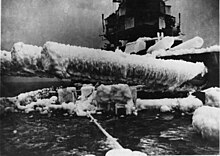
The climatic conditions in the European Arctic Ocean and the Barents Sea presented both attackers and defenders with major problems. In autumn and winter, the weather in the North Sea was determined by frequent storms combined with snow and rain, which resulted in severe visual impairment. The extreme cold caused ice on ships, which resulted in stability problems. There were long polar nights with only short phases of brightness. Furthermore, the Arctic pack ice border shifted further south, so that the convoys had to pass German-occupied Norway at distances of 250 to 200 nautical miles . In summer, the pack ice border shifted further north, but there were now long phases of brightness on the polar day . From July onwards, shallow sea mists increased. The destination port of Murmansk was ice-free all year round, but was close to the German bases. The more distant Arkhangelsk could only be approached in the ice-free period from July to September.
Convoy system
The northern sea convoys consisted of up to 49 merchant ships, which were secured by warships. Escort groups with destroyers, corvettes , minesweepers and other smaller warships were available for local security . These formed a ring around the convoy and were supposed to repel attacks from smaller surface warships and submarines. Air strikes could also be repulsed with the flak . A group of cruisers drove outside the convoy against attacks by larger warships . From 1942, when the Tirpitz was stationed in northern Norway, battleships were also allowed in remote security groups. Furthermore, so-called escort carriers with airplanes were used to take over the air security.

When Convoy PQ 18 with 39 merchant ships, for example, three destroyers, two anti-aircraft ships, four corvettes, four armed were trawlers , three minesweepers and two submarines as Escorts Group divided the Nahsicherung. In addition, an escort carrier and two destroyers to protect him drove with the convoy. As a fighting escort, a light cruiser and 16 destroyers formed a ring around the convoy. The remote security formed two groups with a total of two battleships, three heavy cruisers , one light cruiser and eight destroyers. A reserve group consisting of a heavy and a light cruiser with six destroyers was on standby near Spitsbergen. A submarine group with eight submarines was on the approach of German heavy surface forces. In addition, for the final phase of the escort, the Soviet Navy parked four destroyers and five submarines. A total of 77 warships stood ready to protect the 39 merchant ships. Some of the northern sea convoys were the most heavily secured convoys of World War II.
From the second onwards, all convoys were given a designation made up of a 2-letter code and a subordinate number, sometimes increasing chronologically with departure, ranging from 1 to a maximum of 66. From 1941 to November 1942 the code "PQ" was used for convoys going east and in reverse order "QP" for those going west.
The abbreviation "PQ" is derived from the initials of an officer in the Admiralty's Operations Department, the frigate captain Philip Quellyn Roberts. From December 1942 to 1945 the corresponding abbreviations were JW (eastward) and RA (westward). The numbering was roughly consecutive. PQ 1 to PQ 17 drove eastwards at an average interval of 17 days, QP 1 to QP 12 westwards at an interval of 22 days.
Convoys
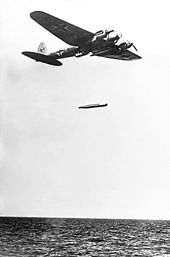
The first convoys (Dervish, PQ 1 to PQ 6) reached the Soviet Union without losses. With them 44 shiploads with 800 fighters, 750 tanks, 1,400 trucks, 100,000 tons of ammunition and other important goods were brought to their ports of destination. In order to be able to fight the convoys more effectively, a change in the command structure began on the German side. With its seat in Kirkenes , the Navy created the office of Admiral Nordmeer ( Vice Admiral Hubert Schmundt ). On the side of the Air Force , the command of the Fliegerführer Nord (East) ( Colonel Alexander Holle ) was created under Air Fleet 5, which is responsible for Scandinavia and Finland . In the spring of 1942 the Luftwaffe massively increased its attack forces. In May 1942 a total of 103 Junkers Ju 88 , 57 Heinkel He 111 and He 115 and 30 Junkers Ju 87 were ready. In addition there were 74 aircraft for sea reconnaissance. Their main bases were in Bardufoss ( Lage ), Banak ( Lage ) and Tromsø ( Lage ). The navy also moved heavy units, including the battleships Tirpitz and Scharnhorst , to northern Norway. Thereupon the commander of the Home Fleet , Admiral John Tovey , wanted to cancel further northern sea convoys. However, he could not prevail. Tovey then said:
"If they must continue for political reasons, very serious losses must be expected."
"If they have to be continued for political reasons, very high losses must be expected."
On the orders of the US-American President Roosevelt, the northern sea convoys were to be specially exposed to the public in order to document the solidarity with the Soviet Union. Because of this, the loss of 43 ships of the convoys PQ 17, PQ 18 and QP 14 within two and a half months was particularly noticed in the Allied press. This created the impression among contemporaries that the northern sea convoys were particularly dangerous.
After the great losses in the summer of 1942, all convoys were stopped and instead individual merchant ships were allowed to sail without safety. Of 13 ships, however, only five made it to their destination port. Then, after a two-month break, they went back to the convoy system.
| designation | Departure | commercial ships |
Arrivals | Allied losses | German losses | Illustration | comment |
|---|---|---|---|---|---|---|---|
| Dervish | August 21, 1941 in Hvalfjörður (Iceland) | 7th | August 31, 1941 in Arkhangelsk (Soviet Union) | no | no | ||
| QP 1 | September 28, 1941 in Arkhangelsk | 14th | October 10, 1941 in Scapa Flow (Great Britain) | no | ? | ||
| PQ 1 | September 29, 1941 in Hvalfjörður | 10 | October 11, 1941 in Arkhangelsk | no | no |  |
HMS Suffolk , 1941 |
| PQ 2 | October 13, 1941 in Liverpool (Great Britain) | 7th | October 30, 1941 in Arkhangelsk | no | no |  |
Empire Baffin freighter |
| QP 2 | November 3, 1941 in Arkhangelsk | 12 | November 17, 1941 in Kirkwall (Great Britain) | no | ? | ||
| PQ 3 | November 9, 1941 in Hvalfjörður | 8th | November 22, 1941 in Arkhangelsk | no | no | 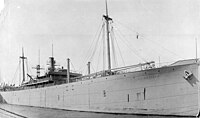 |
Freighter El Capitan |
| PQ 4 | November 17, 1941 in Hvalfjörður | 8th | November 28, 1941 in Arkhangelsk | no | no |  |
The cruiser HMS Berwick was part of the escort |
| QP 3 | November 27, 1941 in Arkhangelsk | 10 | December 3, 1941 in Seyðisfjörður | no | no |  |
Cruiser HMS Kenya |
| PQ 5 | November 27, 1941 in Hvalfjörður | 7th | December 13, 1941 in Arkhangelsk | no | no |  |
The minesweeper HMS Hebe |
| PQ 6 | December 8, 1941 in Hvalfjörður | 8th | December 20, 1941 in Murmansk | no | no |  |
Cruiser HMS Edinburgh |
| PQ 7A | December 26, 1941 in Hvalfjörður | 2 | January 12, 1942 in Murmansk | 1 merchant ship (5,135 GRT ) by U 134 | no |  |
Hvalfjördur in winter (1973) |
| QP 4 | December 20, 1941 in Arkhangelsk | 13 | January 16, 1942 in the Seidisfjord | no | ? | ||
| PQ 7B | December 31, 1941 in Hvalfjörður | 9 | January 11, 1942 in Murmansk | no | no | ||
| designation | Departure | commercial ships |
Arrivals | Allied losses | German losses | Illustration | comment |
| PQ 8 | January 8, 1942 in Hvalfjörður | 8th | January 17, 1942 in Murmansk | Escort destroyer HMS Matabele by U 454 ( location ) | no |  |
The Matabele sank after the submarine attack on convoy PQ 8 |
| QP 5 | January 13, 1942 in Murmansk | 5 | January 19, 1942 | no | ? | ||
| QP 6 | January 24, 1942 in Murmansk | 6th | January 28, 1942 | no | ? | ||
| PQ 9 and PQ 10 | February 1, 1942 in Reykjavík (Iceland) | 10 | February 10, 1942 in Murmansk | no | no | ||
| PQ 11 | February 7, 1942 in Loch Ewe (Great Britain) | 13 | February 22, 1942 in Murmansk | no | no | ||
| QP 7 | February 12, 1942 in Murmansk | 8th | February 22, 1942 in the Seidisfjord | no | ? | ||
| PQ 12 | March 1, 1942 in Reykjavík | 17th | March 12, 1942 in Murmansk | no | no |  |
The Tirpitz tried unsuccessfully to PQ 12 |
| QP 8 | March 1, 1942 in Murmansk | 15th | March 11, 1942 in Reykjavík | 1 merchant ship (2815 GRT) by destroyer Z 14 Friedrich Ihn |
? | 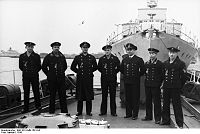 |
Crew of the destroyer "Friedrich Ihn" |
| PQ 13 | March 20, 1942 in Reykjavík | 19th | March 31, 1942 in Murmansk | 2 merchant ships (11,507 GRT) by submarines 2 merchant ships (11,823 GRT) by aircraft 1 merchant ship (4,687 GRT) by destroyer Z 26 1 escort ship (252 t) due to ice damage |
Destroyer Z 26 self- sunk after severe damage |  |
Freighter Raceland (here still as SS Howick Hall ) |
| QP 9 | March 21, 1942 in Kola Bay (Soviet Union) | 19th | April 3, 1942 in Reykjavík | no | no |  |
View of the Kola Bay (2007) |
| PQ 14 | March 26, 1942 in Oban (Great Britain) | 24 | April 19, 1942 in Murmansk | 1 merchant ship (6,985 GRT) by U 403 | no |  |
Cruiser HMS Edinburgh |
| PQ 15 | April 10, 1942 in Oban | 25th | May 5, 1942 in Murmansk | 2 merchant ships by aircraft 1 merchant ship by U 251 destroyer HMS Punjabi sunk after collision with HMS King George V ( location ) |
2 planes |  |
The Punjabi sank after colliding with the King George V at PQ 15 |
 |
The King George V with collision damage at the bow | ||||||
| QP 10 | April 10, 1942 in Kola Bay | 16 | April 21, 1942 in Reykjavík | 2 merchant ships (12,650 GRT) by aircraft 2 merchant ships (11,831 GRT) by U 435 |
no |  |
The El Occidente sank at QP 10 by a torpedo from U 435 ( Lage ) |
| QP 11 | April 28, 1942 in Murmansk | 13 | May 7, 1942 in Reykjavík | 1 merchant ship (2847 BRT) by destroyer Z 7 Hermann Schoemann , Z 24 , Z 25 HMS Edinburgh by U 456 and destroyer Z 25 ( location ) |
Destroyer Z 7 Hermann Schoemann ( location ) |  |
The Edinburgh sank after the submarine and destroyer attack with convoy QP 11 |
| PQ 16 | May 21, 1942 in Reykjavík | 35 | May 30, 1942 in Murmansk | 1 merchant ship (6,191 GRT) by U 703 6 merchant ships (36,987 GRT) by aircraft 1 merchant ship by mine |
3 planes |  |
PQ 16 gathers near Reykjavík |
| QP 12 | May 21, 1942 in Kola Bay | 15th | May 29, 1942 in Reykjavík | no | ? | ||
| QP 13 | June 26, 1942 in Arkhangelsk | 35 | July 7, 1942 in Reykjavík | 6 merchant ships (38,306 GRT) and a minesweeper sunk in their own minefield |
no |  |
The HMS Intrepid was part of the Ocean Escort |
| PQ 17 | June 27, 1942 in Reykjavík | 35 | 4th July 1942 | 15 merchant ships (102,311 GRT) by submarines 8 merchant ships (40,384 GRT) by aircraft |
5 planes |  |
PQ 17 gathers near Iceland |
 |
The El Capitan sank at PQ 17 by a torpedo from U 251 ( Lage ) |
||||||
 |
U 255 after the attack on PQ 17 | ||||||
| PQ 18 | September 2, 1942 in Loch Ewe | 40 | September 21, 1942 in Arkhangelsk | 3 merchant ships (19,742 GRT) by submarines 10 merchant ships (54,725 GRT) by airplanes |
U 88 ( location ) U 589 U 457 ( location ) 33 aircraft |
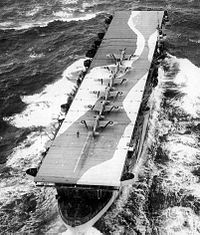 |
The Avenger drove for the first time in PQ 18 |
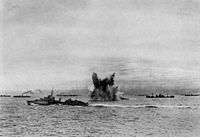 |
Torpedo explosion in PQ 18 | ||||||
| QP 14 | September 13, 1942 in Arkhangelsk | 15th | September 26, 1942 in Loch Ewe | 4 merchant ships (20,762 GRT) by submarines Minesweeper HMS Leda by U 435 destroyer HMS Somali by U 703 ( location ) |
no | 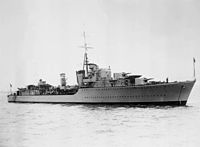 |
The Somali sank after a submarine attack at QP 14 |
 |
The Rathlin acted as a rescue ship in some northern sea convoys |
||||||
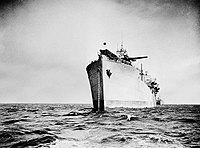 |
The Empire Tide , here equipped with a catapult aircraft , took part in a number of standard convoys |
||||||
| QP 15 | November 17, 1942 in Kola Bay | 28 | November 30, 1942 in Loch Ewe | 2 merchant ships (9,800 GRT) by U 601 and U 625 destroyer Sokrushitelny by storm |
no |  |
The HMS Suffolk was part of the local security group |
| JW 51A | December 15, 1942 in Liverpool | 16 | December 25, 1942 in Kola Bay | no | no | ||
| JW 51B | December 22, 1942 in Liverpool | 15th | January 4, 1943 in Kola Bay | Destroyer HMS Achates by Admiral Hipper ( location ) Minesweeper HMS Bramble by destroyer Z 16 Friedrich Eckoldt ( location )
|
Destroyer Z 16 Friedrich Eckoldt ( location ) | 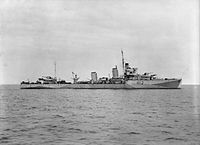 |
The Achates was sunk at the JW 51B by the Admiral Hipper |
| RA 51 | December 30, 1942 in Kola Bay | 14th | January 11, 1943 in Loch Ewe | no | ? | ||
| designation | Departure | commercial ships |
Arrivals | Allied losses | German losses | Illustration | comment |
| JW 52 | January 17, 1943 in Liverpool | 15th | January 27, 1943 in Kola Bay | no | no | ||
| RA 52 | January 29, 1943 in Kola Bay | 10 | February 9, 1943 in Loch Ewe | 1 merchant ship (7460 GRT) by U 255 | no |  |
The HMS Anson was part of the remote backup group |
| JW 53 | February 15, 1943 in Liverpool | 29 | February 27, 1943 in Kola Bay | no | no | 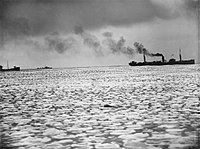 |
Convoy JW 53 in the pack ice |
| RA 53 | March 1, 1943 in Kola Bay | 30th | March 14, 1943 in Loch Ewe | 3 merchant ships (18,245 GRT) by U 255 and U 586 1 merchant ship (6,800 GRT) by storm |
no |  |
The HMS Northern Pride |
| RA 54A | November 1, 1943 in Kola Bay | 13 | November 14, 1943 in Loch Ewe | no | no | ||
| JW 54A | November 15, 1943 in Liverpool | 18th | November 24, 1943 in Kola Bay | no | no | ||
| JW 54B | November 22, 1943 in Liverpool | 14th | December 3, 1943 in Arkhangelsk | no | no | ||
| RA 54B | November 26, 1943 in Arkhangelsk | 8th | December 9, 1943 in Loch Ewe | no | no | ||
| JW 55A | December 12, 1943 in Liverpool | 19th | December 22, 1943 in Arkhangelsk | no | no | ||
| JW 55B | December 20, 1943 in Loch Ewe | 19th | December 30, 1943 in Murmansk | no | Battleship Scharnhorst ( location ) | 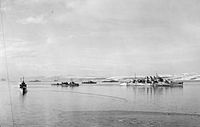 |
The Norfolk is off the Soviet coast with a Northern Convoy |
 |
The British sank the battleship Scharnhorst near the JW 55B |
||||||
| RA 55A | December 22, 1943 in Kola Bay | 22nd | January 1, 1944 in Loch Ewe | no | no | ||
| RA 55B | December 31, 1943 in Kola Bay | 8th | January 8, 1944 in Loch Ewe | no | no | ||
| designation | Departure | Merchant ships | Arrivals | Allied losses | German losses | Illustration | comment |
| JW 56A | January 12, 1944 in Loch Ewe | 20th | January 28 in Arkhangelsk | 1 merchant ship (7,133 GRT) by U 957 1 merchant ship (7,177 GRT) by U 278 1 merchant ship (7,200 GRT) by U 716 |
no | 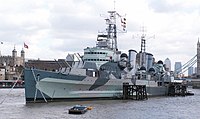 |
HMS Belfast |
| JW 56B | January 22, 1944 in Loch Ewe | 17th | February 1, 1944 in Kola Bay | Destroyer HMS Hardy II by U 278 | U 314 ( location ) |  |
HMS Venus |
| RA 56 | February 3, 1944 in Kola Bay | 37 | February 11, 1944 in Loch Ewe | no | no | ||
| JW 57 | February 20, 1944 in Liverpool | 42 | February 28th in Kola Bay | Destroyer HMS Mahratta by U 990 ( location ) |
U 713 U 601 ( location ) |
 |
Escort carrier HMS Chaser |
| RA 57 | March 2, 1944 in Kola Bay | 31 | March 10, 1944 in Loch Ewe | 1 merchant ship (7,200 GRT) by U 703 |
U 472 ( location ) U 366 ( location ) U 973 ( location ) |
 |
The sister boat HMS Westcott |
| JW 58 | March 27, 1944 in Loch Ewe | 50 | April 4, 1944 in Kola Bay | 1 plane |
U 961 ( location ) U 360 ( location ) U 288 ( location ) U 355 ( location )6 aircraft |
 |
An aircraft of the escort carrier Tracker sank U 288 near JW 58 |
| RA 58 | April 7, 1944 in Kola Bay | 36 | April 14, 1944 in Loch Ewe | no | no | ||
| RA 59 | April 28, 1944 in Kola Bay | 45 | May 6, 1944 in Loch Ewe | 1 merchant ship (7,176 GRT) by U 711 |
U 277 ( location ) U 674 ( location ) U 959 ( location ) |
 |
Escort carrier HMS Fencer |
| JW 59 | August 15, 1944 in Loch Ewe | 35 | August 25, 1944 in Kola Bay | Sloop HMS Kite through U 344 ( location ) |
U 344 ( location ) U 354 ( location ) |
 |
The kite sank after the submarine attack at JW 59 |
| RA 59A | August 28, 1944 in Kola Bay | 9 | September 5, 1944 in Loch Ewe | no | U 394 ( location ) | 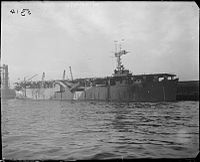 |
Escort carrier HMS Vindex |
 |
Missile- carrying Fairey Swordfish | ||||||
| JW 60 | September 15, 1944 in Loch Ewe | 30th | September 23, 1944 in Kola Bay | no | no | ||
| RA 60 | September 28, 1944 in Kola Bay | 32 | October 5, 1944 in Clyde | 2 merchant ships (14,395 GRT) by U 310 | no |  |
Escort Carrier HMS Striker |
| JW 61 | October 20, 1944 in Loch Ewe | 30th | October 28, 1944 in Kola Bay | no | no | ||
| RA 61 | November 2, 1944 in Kola Bay | 33 | November 9, 1944 in Loch Ewe | no | no | ||
| JW 62 | November 29, 1944 in Loch Ewe | 30th | December 7, 1944 in Kola Bay | no | no | ||
| RA 62 | December 10, 1944 in Kola Bay | 29 | December 19, 1944 in Loch Ewe | Corvette Tunsberg Castle through mine ( location ) |
U 387 ( location ) U 365 ( location )2 planes |
 |
HMS Nairana |
| designation | Departure | commercial ships |
Arrivals | Allied losses | German losses | Illustration | comment |
| JW 63 | January 1, 1945 in Loch Ewe | 35 | January 8, 1945 in Murmansk | no | no | ||
| RA 63 | January 11, 1945 in Kola Bay | 30th | January 21, 1945 in Loch Ewe | no | no | ||
| JW 64 | February 2, 1945 in Clyde (Great Britain) | 26th | February 15, 1945 in the Kola Bay | Corvette HMS Denbigh Castle by U 992 ( location ) | 12 planes |  |
The corvette HMS Denbigh Castle |
| RA 64 | February 17, 1945 in the Kola Bay | 33 | February 28, 1944 in Loch Ewe | 1 merchant ship (7,176 GRT) by aircraft 1 merchant ship (7176 GRT) by U 986 Sloop HMS Lark by U 986 ( location ) Corvette HMS Bluebell by U 711 ( location ) |
6 planes |  |
The Bluebell sank after the submarine attack at RA 64 |
| JW 65 | March 11, 1945 in Clyde | 26th | March 21, 1945 in Kola Bay | 1 merchant ship (7,176 GRT) by U 995 1 merchant ship (7,210 GRT) by U 968 Sloop HMS Lapwing by U 968 |
no |  |
HMS diadem |
| RA 65 | March 21, 1945 in Kola Bay | 26th | April 1, 1945 in Clyde | no | no | ||
| JW 66 | April 6, 1945 in Clyde | 26th | April 29, 1945 in the Kola Bay | no | no | ||
| RA 66 | April 29, 1945 in the Kola Bay | 27 | May 8, 1945 in Clyde | Frigate HMS Goodall by U 986 | U 307 ( location ) |  |
Escort carrier HMS Premier |
Conclusion

811 shiploads were organized in 40 convoy trains going east. 58 ships were sunk, while 33 times a ship had to turn back for various reasons. A total of 720 shiploads reached their destination port. In the 37 returning convoy trains with a total of 715 merchant ships (multiple counting), 29 merchant ships were lost. In addition, 13 British warships were sunk. The British sank the battleship Scharnhorst , three destroyers and 43 submarines.
The Allies brought a total of four million tons of cargo, including 5,000 tanks and 7,000 aircraft, to the Soviet Union via the northern sea escort route. That was almost 23 percent of all goods delivered to the Soviet Union at that time. Larger proportions ran on the other two less lossy routes ( Persian Corridor , Pacific Route ), which could not be disturbed by the Germans.
See also
Individual evidence
- ^ Johan Blindheim: Ecological Features of the Norwegian Sea. In: Louis René Rey et al. (Ed.): Marine Living Systems of the Far North. 6th Conference. Papers. Brill Archive, 1989, ISBN 90-04-08281-6 , p. 366.
- ↑ a b c Werner Rahn : The German Empire and the Second World War . Volume 6, Deutsche Verlags-Anstalt , Stuttgart 1990, ISBN 3-421-06233-1 , p. 407.
- ↑ Clay Blair : The Submarine War . tape 2 : The hunted 1942–1945 . Wilhelm Heyne Verlag, Munich 1999, ISBN 3-453-16059-2 , p. 51 (English: Hitler's U-boat war. The hunted 1942–1945 . Translated by Helmut Dierlamm).
- ^ Richard Woodman The Arctic Convoys 1941–1945. John Murray Ltd., London 1995, ISBN 0719550793 , p. 42.
- ↑ Clay Blair: The U-Boat War, The Jäger 1939-1942. Wilhelm Heyne Verlag, Munich 1998, ISBN 3-453-12345-X , p. 425.
- ↑ Gerd R. Ueberschär : The German Empire and the Second World War. Volume 4, Deutsche Verlags-Anstalt, Stuttgart 1983, ISBN 3-421-06098-3 , pp. 824-825.
- ↑ a b Werner Rahn: The German Empire and the Second World War. Volume 6, Deutsche Verlags-Anstalt, Stuttgart 1990, ISBN 3-421-06233-1 , p. 412.
- ↑ Clay Blair: The U-Boat War, The Jäger 1939-1942. Wilhelm Heyne Verlag, Munich 1998, ISBN 3-453-12345-X , p. 741.
- ^ A b Clay Blair : The Submarine War . tape 2 : The hunted 1942–1945 . Wilhelm Heyne Verlag, Munich 1999, ISBN 3-453-16059-2 , p. 54 (English: Hitler's U-boat war. The hunted 1942–1945 . Translated by Helmut Dierlamm).
- ↑ Werner Rahn: The German Empire and the Second World War. Volume 6, Deutsche Verlags-Anstalt, Stuttgart 1990, ISBN 3-421-06233-1 , p. 418.
- ↑ Werner Rahn: The German Empire and the Second World War. Volume 6, Deutsche Verlags-Anstalt, Stuttgart 1990, ISBN 3-421-06233-1 , p. 405.
- ↑ a b c d e f g Brian Betham Schofield : Convoy battles. Köhlers Verlagsgesellschaft mbH, Herford (1983), ISBN 3-453-01759-5 , p. 175.
- ↑ The battleship Tirpitz with three destroyers could not find the convoy.
- ↑ Werner Rahn: The German Empire and the Second World War. Volume 6, Deutsche Verlags-Anstalt, Stuttgart 1990, ISBN 3-421-06233-1 , p. 409.
- ↑ a b c d e f g Brian Betham Schofield : Convoy battles. Köhlers Verlagsgesellschaft mbH, Herford (1983), ISBN 3-453-01759-5 , p. 176.
- ↑ Eric Grove: Sea Battles in Close-Up: World War II. Volume Two, Naval Institute Press, Annapolis, Maryland 1993, ISBN 1-55750-758-9 , pp. 117-121.
- ↑ a b Percy E. Schramm : War Diary of the High Command of the Wehrmacht 1942. Part 2, Bernard & Graefe Verlag, Bonn, ISBN 3-7637-5933-6 , p. 1409.
- ↑ a b c Percy E. Schramm: War Diary of the High Command of the Wehrmacht 1942. Volume 2, Bernard & Graefe Verlag, Bonn, ISBN 3-7637-5933-6 , p. 1411.
- ^ Jürgen Rohwer , Gerhard Hümmelchen : Chronology of the War at Sea 1939–1945. Naval Institute Press, Annapolis, Maryland 1992, ISBN 1-55750-105-X , p. 137.
- ^ Percy E. Schramm: War Diary of the High Command of the Wehrmacht 1942. Part 2, Bernard & Graefe Verlag, Bonn, ISBN 3-7637-5933-6 , p. 1413.
- ↑ Percy E. Schramm: War Diary of the High Command of the Wehrmacht 1942. Part 2, Bernard & Graefe Verlag, Bonn, ISBN 3-7637-5933-6 , p. 1417.
- ↑ Convoy PQ 17 was the allied convoy with the greatest losses in World War II in terms of the number of ships sunk and the tonnage.
- ↑ Werner Rahn: The German Empire and the Second World War. Volume 6, Deutsche Verlags-Anstalt, Stuttgart 1990, ISBN 3-421-06233-1 , pp. 413-417.
- ↑ For the first time, an escort carrier (HMS Avenger ) accompanied twelve fighters and three bombers in the convoy.
- ↑ Clay Blair : The Submarine War . tape 2 : The hunted 1942–1945 . Wilhelm Heyne Verlag, Munich 1999, ISBN 3-453-16059-2 , p. 50–54 (English: Hitler's U-boat war. The hunted 1942–1945 . Translated by Helmut Dierlamm).
- ↑ Jürgen Rohwer, Gerhard Hümmelchen: Chronik des Maritime War 1939–1945, September 1942 , accessed on July 27, 2013.
- ↑ Werner Rahn: The German Empire and the Second World War. Volume 6, Deutsche Verlags-Anstalt, Stuttgart 1990, ISBN 3-421-06233-1 , p. 419.
- ↑ Werner Rahn: The German Empire and the Second World War. Volume 6, Deutsche Verlags-Anstalt, Stuttgart 1990, ISBN 3-421-06233-1 , pp. 419-422.
- ↑ Jürgen Rohwer, Gerhard Hümmelchen: Chronik des Maritime War 1939–1945, February 1943 , accessed on August 8, 2013.
- ↑ Jürgen Rohwer , Gerhard Hümmelchen: Chronik des Maritime War 1939–1945, March 1943 , accessed on July 26, 2013.
- ↑ a b c d e Clay Blair : The Submarine War . tape 2 : The hunted 1942–1945 . Wilhelm Heyne Verlag, Munich 1999, ISBN 3-453-16059-2 , p. 553 (English: Hitler's U-boat war. The hunted 1942–1945 . Translated by Helmut Dierlamm).
- ^ A b Clay Blair : The Submarine War . tape 2 : The hunted 1942–1945 . Wilhelm Heyne Verlag, Munich 1999, ISBN 3-453-16059-2 , p. 553–555 (English: Hitler's U-boat war. The hunted 1942–1945 . Translated by Helmut Dierlamm).
- ↑ Clay Blair : The Submarine War . tape 2 : The hunted 1942–1945 . Wilhelm Heyne Verlag, Munich 1999, ISBN 3-453-16059-2 , p. 603–604 (English: Hitler's U-boat war. The hunted 1942–1945 . Translated by Helmut Dierlamm).
- ^ A b Clay Blair : The Submarine War . tape 2 : The hunted 1942–1945 . Wilhelm Heyne Verlag, Munich 1999, ISBN 3-453-16059-2 , p. 604 (English: Hitler's U-boat war. The hunted 1942–1945 . Translated by Helmut Dierlamm).
- ↑ Clay Blair : The Submarine War . tape 2 : The hunted 1942–1945 . Wilhelm Heyne Verlag, Munich 1999, ISBN 3-453-16059-2 , p. 604–605 (English: Hitler's U-boat war. The hunted 1942–1945 . Translated by Helmut Dierlamm).
- ↑ Clay Blair : The Submarine War . tape 2 : The hunted 1942–1945 . Wilhelm Heyne Verlag, Munich 1999, ISBN 3-453-16059-2 , p. 605 (English: Hitler's U-boat war. The hunted 1942–1945 . Translated by Helmut Dierlamm).
- ↑ Clay Blair : The Submarine War . tape 2 : The hunted 1942–1945 . Wilhelm Heyne Verlag, Munich 1999, ISBN 3-453-16059-2 , p. 606–607 (English: Hitler's U-boat war. The hunted 1942–1945 . Translated by Helmut Dierlamm).
- ↑ Clay Blair : The Submarine War . tape 2 : The hunted 1942–1945 . Wilhelm Heyne Verlag, Munich 1999, ISBN 3-453-16059-2 , p. 607 (English: Hitler's U-boat war. The hunted 1942–1945 . Translated by Helmut Dierlamm).
- ↑ Clay Blair : The Submarine War . tape 2 : The hunted 1942–1945 . Wilhelm Heyne Verlag, Munich 1999, ISBN 3-453-16059-2 , p. 607–608 (English: Hitler's U-boat war. The hunted 1942–1945 . Translated by Helmut Dierlamm).
- ↑ Clay Blair : The Submarine War . tape 2 : The hunted 1942–1945 . Wilhelm Heyne Verlag, Munich 1999, ISBN 3-453-16059-2 , p. 699–700 (English: Hitler's U-boat war. The hunted 1942–1945 . Translated by Helmut Dierlamm).
- ↑ a b c d e Clay Blair : The Submarine War . tape 2 : The hunted 1942–1945 . Wilhelm Heyne Verlag, Munich 1999, ISBN 3-453-16059-2 , p. 701 (English: Hitler's U-boat war. The hunted 1942–1945 . Translated by Helmut Dierlamm).
- ↑ a b c d Clay Blair : The Submarine War . tape 2 : The hunted 1942–1945 . Wilhelm Heyne Verlag, Munich 1999, ISBN 3-453-16059-2 , p. 787 (English: Hitler's U-boat war. The hunted 1942–1945 . Translated by Helmut Dierlamm).
- ↑ Jürgen Rohwer, Gerhard Hümmelchen: Chronik des Maritime War 1939–1945, February 1945 , accessed on August 11, 2013.
- ↑ Jürgen Rohwer, Gerhard Hümmelchen: Chronicle of the Sea War 1939–1945, February 1942 , accessed on August 13, 2013.
- ^ A b Clay Blair : The Submarine War . tape 2 : The hunted 1942–1945 . Wilhelm Heyne Verlag, Munich 1999, ISBN 3-453-16059-2 , p. 789 (English: Hitler's U-boat war. The hunted 1942–1945 . Translated by Helmut Dierlamm).
- ↑ Clay Blair : The Submarine War . tape 2 : The hunted 1942–1945 . Wilhelm Heyne Verlag, Munich 1999, ISBN 3-453-16059-2 , p. 789–790 (English: Hitler's U-boat war. The hunted 1942–1945 . Translated by Helmut Dierlamm).
- ↑ Clay Blair : The Submarine War . tape 2 : The hunted 1942–1945 . Wilhelm Heyne Verlag, Munich 1999, ISBN 3-453-16059-2 , p. 790 (English: Hitler's U-boat war. The hunted 1942–1945 . Translated by Helmut Dierlamm).
- ↑ Clay Blair : The Submarine War . tape 2 : The hunted 1942–1945 . Wilhelm Heyne Verlag, Munich 1999, ISBN 3-453-16059-2 , p. 791 (English: Hitler's U-boat war. The hunted 1942–1945 . Translated by Helmut Dierlamm).
- ↑ Edward L. Killham: The Nordic Way. A Path to Baltic Equilibrium. Howells House, 1993, ISBN 0-929590-12-0 , p. 106.
- ↑ Clay Blair : The Submarine War . tape 2 : The hunted 1942–1945 . Wilhelm Heyne Verlag, Munich 1999, ISBN 3-453-16059-2 , p. 792 (English: Hitler's U-boat war. The hunted 1942–1945 . Translated by Helmut Dierlamm).
